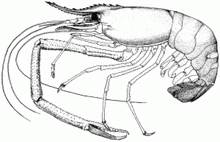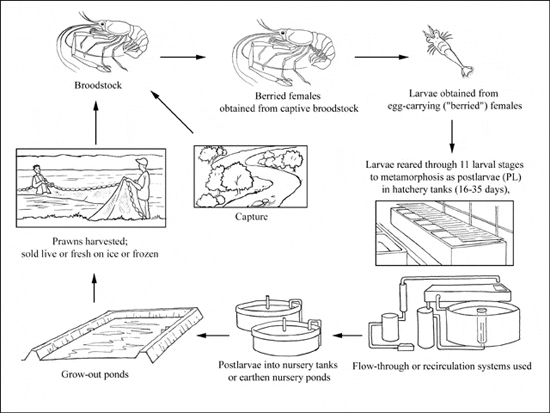Habitat and biology
Gravid females migrate downstream into estuaries, where eggs hatch as free-swimming larvae in brackishwater.Before metamorphosis into postlarvae (PL), the planktonic larvae pass through several zoeal stages. After metamorphosis, PL assume a more benthic life style and begin to migrate upstream towards freshwater. Larvae swim actively tail first, ventral side uppermost. From PL onwards prawns swim forwards, dorsal side uppermost. From metamorphosis onwards prawns can also walk, not only on the sub-stratum but also over damp areas including stones by river edges, up vertical surfaces (small waterfalls, weirs, etc.) and across land. Larvae mostly consume zooplankton (mainly minute crustaceans), very small worms, and larval stages of other crustaceans.

Postlarvae and adults are omnivorous, eating algae, aquatic plants, molluscs, aquatic insects, worms, and other crustaceans. Males and females have different growth rates and males exhibit heterogenous individual growth (HIG); these are vitally important factors in grow-out management. Three distinct male morphotypes (and a number of intermediary types) exist: small male (SM), orange claw males (OC), and blue claw males (BC). The normal male developmental pathway is SM → OC → BC. BC males have extremely long second pereiopods; those of OC males are golden coloured; SM have small, slim, almost translucent claws. The type and behaviour of the males affects the growth rates of other prawns. The transition from rapidly growing OC to the slowly growing BC morphotype follows a "leapfrog" growth pattern. An OC metamorphoses into a BC only after it has become larger than the largest BC in its vicinity. The presence of this new BC male then delays the transition of the next OC to the BC morphotype, causing it to attain a larger size following its metamorphosis. BC males dominate OC males, regardless of their size, and suppress the growth of SM.
Production
Production cycle

Macrobrachium rosenbergii production cycle
Production systems
Seed supply
When required for hatchery use, female broodstock are usually obtained from grow-out ponds but also sometimes from capture fisheries. Normally, "berried" (egg-carrying) females are only used once. Commercial farms in tropical regions do not normally maintain captive broodstock for breeding purposes but adults are over-wintered indoors in temperate regions in order to stock ponds with PL as early as possible in the short grow-out season. The typical male to female ratio in broodstock holding systems is 1-2 BC males or 2-3 OC males per 20 females, at a total stocking density of 1 prawn per 40 litres. Within a few hours of copulation, fertilization occurs externally, as the eggs are transferred to the brood chamber beneath the abdomen. The eggs remain adhered to the female during embryonic development, which lasts about 3 weeks. At hatching, free-swimming zoeae are produced. Between 5000 and 100 000 eggs are carried, depending on the size of the berried female. Eggs are orange until 2-3 days before hatching, when they become grey-black.
Some seed (PL; juveniles) is obtained from the capture fishery where M. rosenbergii is indigenous, typically in the Indian sub-continent, but most is now hatchery-reared. First stage zoeae are just under 2 mm long and grow, through 11 larval stages, to almost 8 mm at metamorphosis into PL. Individual metamorphosis can be achieved in as little as 16 days but usually takes much longer, depending on environmental conditions. In commercial hatcheries, most larvae metamorphose by day 32-35 at the optimum temperature (28-31°C). Larval rearing typically occurs in 12‰ brackishwater, and hatcheries are either flow-through (where a proportion of the rearing water is regularly replaced) or recirculating (where a variety of systems involving physical and biological filters are used to minimise water use). Either type of hatchery may be inland or coastal. Inland hatcheries produce brackishwater by mixing freshwater with seawater transported from the coast, brine trucked from salt pans, or artificial seawater. Some flow-through hatcheries use a "greenwater" system, which involves fertilization to encourage the growth of phytoplankton (mainly Chlorella spp.), which is believed to improve water quality and increase larval survival; others operate a "clearwater" regime. Feeding systems vary widely but typically include brine shrimp (Artemia salina) fed several times per day at first, reducing to a single daily feed by larval stage 10. Prepared feed (usually an egg custard containing mussel or fish flesh, squid, or other ingredients) is introduced at stage 3 and its feeding frequency is increased towards metamorphosis. Some hatcheries are integrated with nursery and grow-out facilities.
Nursery
Although some farmers stock grow-out ponds with young PL, many either purchase larger juveniles or rear PL in their own nursery ponds before transfer to grow-out ponds. In temperate areas with a limited grow-out season, environmentally controlled indoor nurseries are used to increase animal size before stocking outdoors as soon as temperatures become high enough. Indoor nurseries are stocked at 1000-2000 PL/m³, depending on whether substrates are used or not. Outdoor nurseries may be stocked with newly metamorphosed PL or with juveniles from an indoor nursery. Typically, stocking rates are 1000/m² PL, 200/m² small juveniles (0.02g) or 75/m² of 0.3-0.4 g juveniles, but increased densities are possible if substrates are used.
Ongrowing techniques
Freshwater prawns are reared in a variety of freshwater enclosures, including tanks, irrigation ditches, cages, pens, reservoirs, and natural waters; the commonest form being earthen ponds. Normal rearing methods comprise various combinations of the formerly used "continuous" (ponds operated indefinitely, with regular cull-harvesting and restocking) and "batch" (single stocking, single harvesting) systems; these are known as "combined systems". Most systems involve monoculture, but the polyculture of freshwater prawns with finfish and sometimes other crustaceans also occurs, particularly in China (with carps). Integration of freshwater prawn culture with crop production also occurs (typically in Viet Nam).
Pond stocking densities in tropical monoculture vary widely. In extensive rearing systems (typically producing <500 kg/ha/yr), PL or young juveniles are stocked at 1-4/m²; semi-intensive systems (producing 500-5000 kg/ha/yr) are stocked at 4-20 PL or young juveniles/m². Rarely, some small intensive systems also exist, which stock >20/m² to achieve >5000 kg/ha/yr. In temperate areas with a limited rearing window of opportunity about 5-10 PL/m² or 4 juveniles/m² are stocked; levels can be increased in presence of substrates.
The prawns are fed commercial or "farm-made" feeds, the latter being single or mixtures of ingredients, often extruded through mincers and either fed moist or (usually) after sun-drying. Feeds with 5 per cent lipid and 30-35 per cent protein are commonplace and an FCR of 2:1 or 3:1 is achieved with dry diets. Average growth rates depend on many factors, particularly the way in which male HIG is managed. The growth rate of SM is stunted by the presence of BC males; in their absence SM metamorphose into OC and ultimately into BC males. Thus the way in which grow-out ponds are managed (for example, the frequency of culling out large prawns, mostly males) influences total productivity.
Harvesting techniques
Harvesting is either total (in "batch" rearing) or partial (in "continuous" or "combined" rearing). Total harvesting is achieved by gravity drain-down or water removal through pumping, while seine nets are used for regularly culling larger animals. Stretched knot mesh sizes of 1.8 cm are use to harvest small prawns and from 3.8-5.0 cm for large prawns. The time and frequency of harvesting depends entirely on the volume and characteristics (the animal size) of market demand.
Handling and processing
Careful handling is essential from harvesting onwards to ensure good quality products. Freshwater prawns tend to go "mushy" if not handled and processed correctly. Firstly, it is essential to prevent prawns from becoming crushed during harvesting. Secondly, if they are not going to be sold live, they should be killed in a mixture of water and ice at 0°C immediately (at the pond bank), and washed in chlorinated tap water. Prawns for live sale can be transported in aerated water at 20-22°C. Prawns sold fresh must not be kept on ice for more than 3 days. Prawns for sale frozen must be quick-frozen at -10°C (not simply placed in a "domestic" freezer) and stored at -20°C or below.
Production costs
Providing production cost data is difficult, not only because the information is usually proprietary but also because it is site-specific. For example, one review of hatchery operating costs (all figures were normalised to 1997 US$) gave an average of US$ 10.6/1000 PL but the range was US$ 1.1 to 17.0/1000 PL. Hatchery investment costs ranged from US$ 12.4-19.0 per 1000 PL production capacity. Nursery investment costs for producing 4 million 2 g juveniles in Latin America, for example, has been quoted as US$ 50 000. Nursery operating costs have been quoted as US$ 6 per thousand 2 g juveniles and US$ 50 per thousand 10 g juveniles in Thailand. Typically, feed expenses represented at least 40 per cent of total nursery production costs. Investment costs for grow-out facilities have been cited as ranging from US$ 400/ha (yielding 600 kg/ha/yr) in India to nearly US$ 64 000/ha (yielding 2270 kg/ha/yr) in the USA. Similarly, grow-out operating costs from less than US$ 2 to more than US$ 15/kg/yr have been cited. The average cost split was 30 per cent feeding, 20 per cent seed, 15 per cent labour and 35 per cent other expenses.
April 2009




